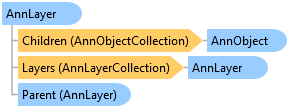| Leadtools.Annotations.Core Namespace : AnnLayer Class |

public class AnnLayer
Public Class AnnLayer
public sealed class AnnLayer
public class AnnLayer;
function Leadtools.Annotations.Core.AnnLayer()
AnnLayer objects can be used to logically group common annotation objects. An AnnContainer object contains a collection of AnnObjects (AnnContainer.Children) and a collection of AnnLayers (AnnContainer.Layers). The layers are organized in a parent/children tree collection, with the main container defined as the root layer. The parent/children relationship controls the z-order of the objects in the layer as well as how the various hit-test methods are performed on the container. It also controls the z-ordering used when designing or running automation.
Each AnnObject in the container is also included in a layer in the same container (by default, they are added to the root layer which is the container itself).
If required, a layer hierarchy can be created inside the container using the following steps:
After a layer hierarchy is created, you can use the following methods to easily manipulate the layers:
Any layer can be designated as the active layer in the container using AnnContainer.ActiveLayer. The active container is null by default denoting the default layer in the container. When new objects are drawn in the container using automation, they are added to the active container.
The layer hierarchy is automatically saved and loaded using AnnCodecs.
For an example, refer to the AnnotationsLayerDemo in your LEADTOOLS setup.